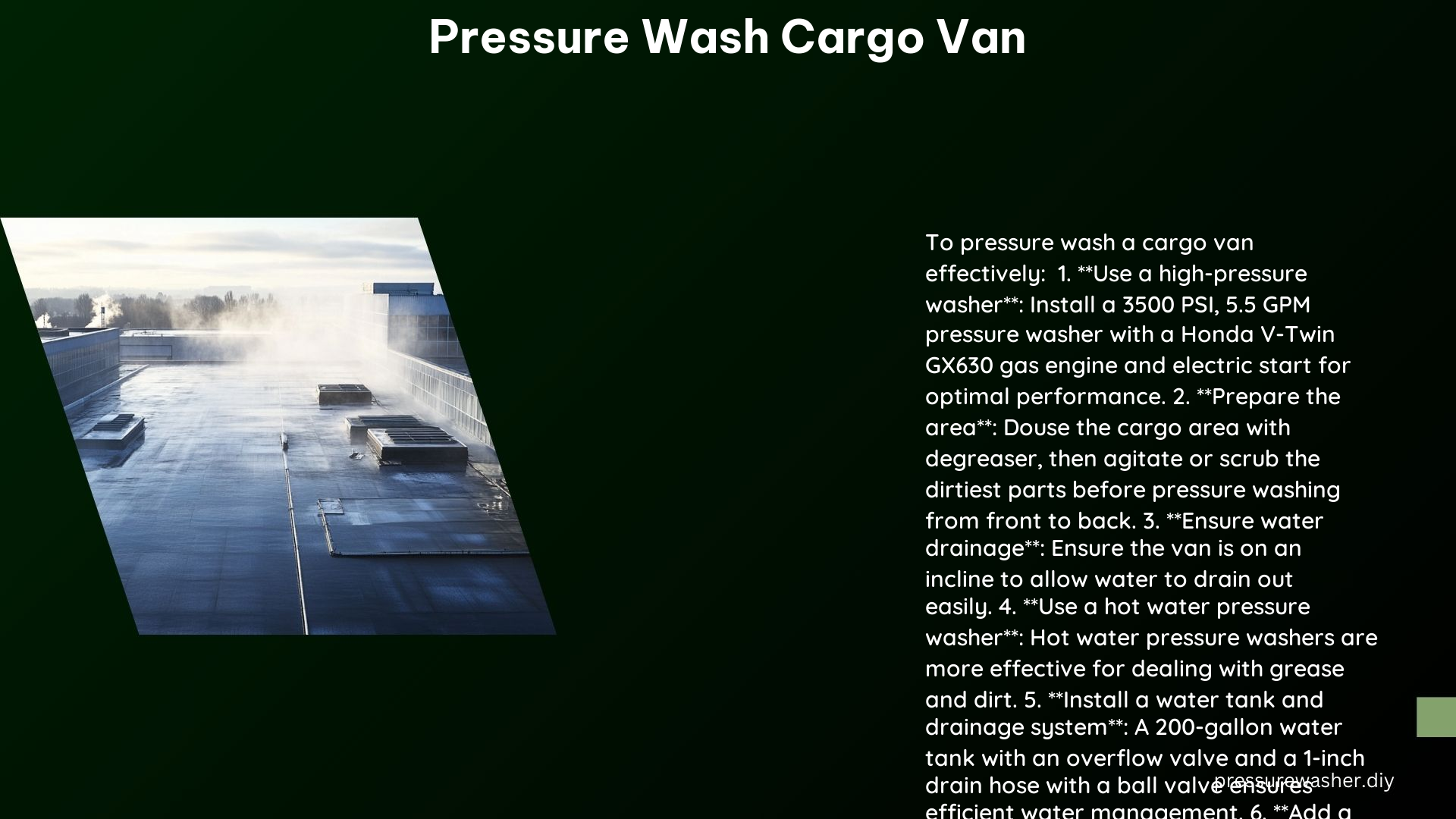Maintaining a clean and well-kept cargo van is essential for both professional and personal use. Whether you’re a contractor, a delivery driver, or simply someone who uses their van for hauling, keeping the cargo area in pristine condition can enhance the vehicle’s appearance, improve its resale value, and ensure a safe and organized workspace. In this comprehensive guide, we’ll delve into the step-by-step process of pressure washing your cargo van, providing you with the technical specifications, best practices, and expert recommendations to ensure a thorough and effective cleaning.
Preparing the Cargo Area for Pressure Washing
Before you begin the pressure washing process, it’s crucial to properly prepare the cargo area. This step ensures that you can effectively clean the surface without causing any damage to sensitive components or electronics.
-
Remove Loose Debris: Start by removing any loose items, such as tools, equipment, or cargo, from the cargo area. This will allow you to access all the surfaces and ensure a comprehensive clean.
-
Cover Sensitive Components: Identify any sensitive electronic components or wiring that may be present in the cargo area. Carefully cover these items with plastic sheeting or a tarp to protect them from water damage during the pressure washing process.
-
Inspect for Drainage Holes: Examine the cargo area for any existing drainage holes or channels. These features are essential for allowing water to properly escape the space, preventing the accumulation of moisture and potential damage to the van’s structure.
Applying Degreaser and Agitating the Surface

Once the cargo area is prepared, the next step is to apply a degreaser and agitate the surface to loosen any built-up dirt, grime, or grease.
-
Degreaser Application: Choose a high-quality degreaser that is specifically formulated for use on automotive surfaces. Mix the degreaser according to the manufacturer’s instructions, and use a bug sprayer or a similar applicator to evenly distribute the solution throughout the cargo area.
-
Agitation and Scrubbing: After allowing the degreaser to dwell for the recommended time, use a stiff-bristle broom or a dedicated wash brush to agitate and scrub the dirtiest areas, particularly those with heavy grease buildup. This mechanical action will help to further loosen and lift the contaminants from the surface.
Pressure Washing the Cargo Area
With the cargo area prepped and the surface agitated, it’s time to bring in the pressure washer for the final cleaning step.
-
Pressure Washer Selection: Choose a pressure washer that is suitable for your cargo van’s materials and construction. A general recommendation is to use a pressure washer with a PSI (pounds per square inch) range of 1,500 to 2,000 PSI. However, it’s essential to consult your van’s manufacturer or a professional pressure washing expert to ensure you’re using the appropriate equipment.
-
Hot Water Pressure Washing: For optimal cleaning performance, consider using a hot water pressure washer. The elevated water temperature can be more effective in breaking down and removing stubborn grease, oil, and grime from the cargo area surfaces.
-
Cleaning Technique: Methodically work your way through the cargo area, starting from the front and moving towards the rear. Maintain a consistent distance from the surface (typically around 6-12 inches) and use overlapping passes to ensure complete coverage.
-
Drainage Considerations: Pay close attention to the cargo area’s drainage capabilities. If your van does not have built-in drainage holes, you may need to take additional precautions to prevent water accumulation and potential damage.
Drying and Finishing Touches
After the pressure washing is complete, the final step is to ensure the cargo area is properly dried and ready for use.
-
Air Drying: Allow the cargo area to air dry naturally, ensuring that all surfaces are completely free of moisture. This process may take some time, depending on the size of the cargo area and the ambient conditions.
-
Accelerated Drying: If you’re in a hurry, you can use a mop or a squeegee to help speed up the drying process. Carefully remove any standing water and ensure the surfaces are left with a clean, dry finish.
Technical Specifications for Pressure Wash Cargo Van Installations
To provide you with a better understanding of the technical requirements for pressure washing cargo vans, here are some examples of customizable installations:
- Customizable Ford 250 (2015-2022) Van Installation:
- 5.5 GPM (Gallons Per Minute) cold water pressure washer
-
Total cost: $12,204.00
-
Customizable 2020 Ford Transit Van High Roof Dually Installation:
- 3500 PSI, 10 GPM cold pressure washer
- 300 PSI, 10 GPM gas soft wash system
- Comprehensive installation package
Remember, these are just examples, and the specific technical requirements for your cargo van may vary based on factors such as the make, model, year, and the unique features of your vehicle. It’s always best to consult with a professional pressure washing expert to ensure you select the appropriate equipment and installation for your needs.
Conclusion
Maintaining a clean and well-kept cargo van is essential for both professional and personal use. By following the step-by-step process outlined in this comprehensive guide, you can effectively pressure wash your cargo area, ensuring a thorough and efficient cleaning. Remember to always prioritize safety, use the appropriate equipment, and consult with experts when necessary to achieve the best results for your cargo van.
References:
- https://www.reddit.com/r/Detailing/comments/wvsxon/how_to_clean_the_back_of_this_cargo_van/
- https://www.metrisforum.com/threads/power-wash-cargo-area.6458/
- https://3rpressurewashers.com/products/customizable-ford-250-2015-2022-van-installation-5-5-gpm-cold-water-washer/
- https://www.thedieselstop.com/threads/pressure-washing-inside-of-van-a-good-idea.278466/
- https://3rpressurewashers.com/product-category/customizable-mobile-wash-builds/pressure-washer-and-soft-wash-van-installations/
